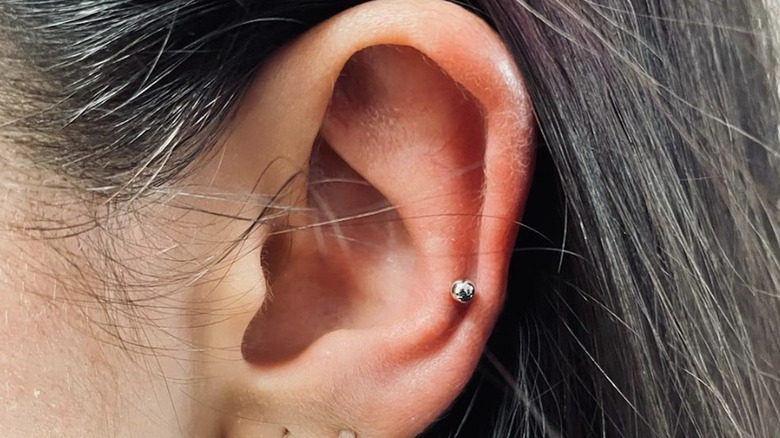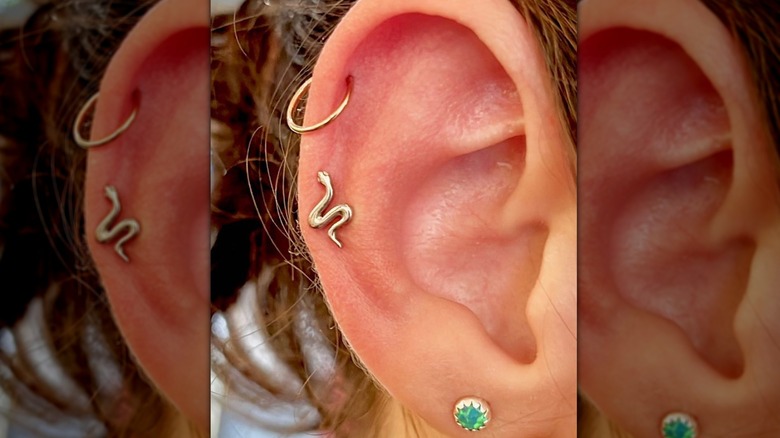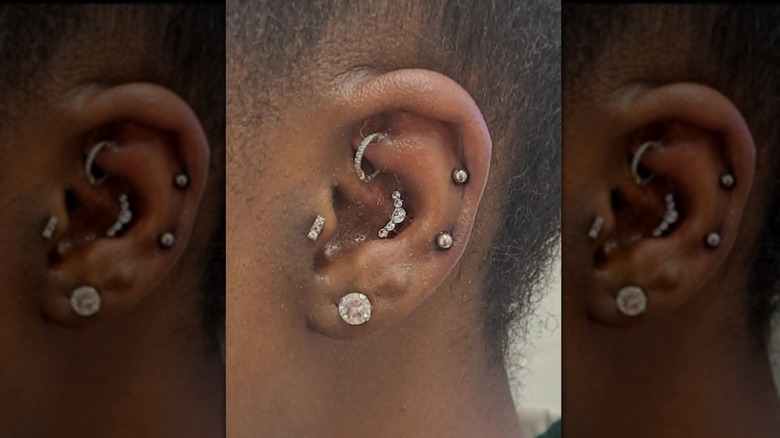Your Guide To Auricle Piercings
When it comes to body modification, piercings are a great option. Unlike tattoos, they're low-commitment and certainly don't hurt as much. Piercings can also be put anywhere on your body — somewhat terrifying, but true — making them just as unique as tattoos, but in their own way.
One type of piercing that's fun and looks fantastic is the auricle piercing along the outside of the ear. "An auricle piercing is placed at the midpoint along the helix," senior manager of content and community at Studs Jenn Lee told Popsugar. "We refer to it as the midi-helix or 'midi.'" This piercing is far up enough to be relatively discreet — if that's what you're looking for — or it can be part of a larger compilation of earrings that create the very en-vogue earscaping piercing trend. It's a piercing that can fit any type of lifestyle, from modest to super trendy, thanks to its placement.
But just because something looks cool and those around us may be able to rock it perfectly, doesn't mean that it's something we should immediately run out and get. Granted, piercings are temporary (if we want them to be), but with body modification, there are still things to consider before jumping on the bandwagon.
Cost and healing time of auricle piercings
As with any piercings, it's important to have an idea of how much it costs before making an appointment. Although prices fluctuate depending on where you live, the piercing itself should be between $30 and $50, per FreshTrends. Depending on what type of jewelry you choose, especially regarding the metal, will bump this price up. Platinum or gold will, of course, be more expensive than sterling silver. If you choose to do a double, triple, or quadruple auricle piercing at the same time, then that will increase the overall price too.
When you do get pierced, choose a stud you really like, because it's staying put for a while. "The diameter and thickness of the ring that would be needed for healing is not usually what people would want aesthetically," body piercer Cassi Lopez-March told Refinery 29. "Rings also move a ton, which leads to irritation." While everyone's body heals at a different rate, the auricle piercing takes between three to nine months. If you're someone whose body takes its time, then it could be as long as a year before the piercing is 100% healed. When dealing with a cartilage piercing, "most of the surface healing happens in the first 12 weeks or so," body piercer Sarah Lacy, RN told Self. "However, the deeper part of the piercing still needs a full year to heal." Because of this, you shouldn't change out your starter stud until you've reached that 12-week point.
Downsides to auricle piercings
Not only do auricle piercings take a while to heal, but if you don't keep up with aftercare, the healing process takes even longer. The first thing to keep in mind is not to play with your new piercing and when you do touch it — only to clean it — make sure you've washed your hands. "Spray the front and back of your piercing with sterile saline solution two to three times a day," senior manager of content and community at Studs Jenn Lee told Popsugar. It's important not to overdo it, and always pat the piercing dry afterward. If you run out of saline, alcohol or hydrogen peroxide will NOT make good substitutes, as they can be very drying.
You also want to be wary of how your ear is pierced. While a gun is quicker, it can damage the tissue resulting in scarring or even cauliflower ear. "With a needle, we have more control of accuracy, and it's totally sterile," piercer J. Colby Smith told Elle. "It works like a scalpel, making a small incision into the tissue, leaving minimal damage to the area ... if a needle piercing is done properly, the pain is very minor." If you don't like the idea of a needle penetrating your cartilage, then this probably isn't for you.
While there's no denying auricle piercings look cool, you still want to think before you pierce. It may be low commitment, comparatively speaking, but that doesn't mean it's commitment-free.


